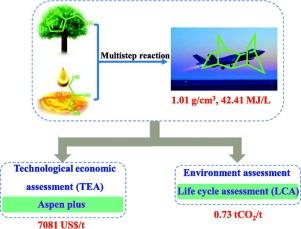异体生物质衍生甘油和糠醇串联催化绿色合成可持续高能量密度喷气燃料
IF 13.2
1区 工程技术
Q1 ENGINEERING, CHEMICAL
引用次数: 0
摘要
可持续木质纤维素生物质催化转化为高能量密度喷气燃料(HEDJFs)对于减少二氧化碳排放和扩大飞机的应用场景至关重要。本文研究了一种经济、高产、低碳的以甘油和糠醛为原料的串联催化合成HEDJFs的方法。首先,用FeZn-F68催化糠醛水相重排,在Zn3Mo2O9上一步催化生成环戊二烯。其次,通过液相脱水、cross-Diels-Alder反应、脱羰反应得到降冰片烯。最后,通过环戊二烯与降冰片烯的自/交叉diels - alder反应并加氢得到HEDJFs。x射线吸收近边结构(XANES)、扩展x射线吸收精细结构(EXAFS)、电子顺磁共振(EPR)、密度泛函理论(DFT)等表征结果表明,FeZn-F68的高活性是由于受挫刘易斯对的形成而同时具有酸性和氢化能力。Zn3Mo2O9的优异性能是由于它具有较高的还原性和更多的氧空位。合成的HEDJFs具有较高的密度(1.01 g/cm3)和体积净燃烧热(42.41 MJ/L)。技术经济分析和生命周期评价表明,生产1吨hedjf需要4.485吨糠醛和0.783吨甘油,在此过程中排放0.73吨二氧化碳。值得注意的是,与传统的石油衍生航空燃料相比,这种方法可以减少83.4 %的碳排放。本文章由计算机程序翻译,如有差异,请以英文原文为准。

Green synthesis of sustainable high-energy-density jet fuels via tandem catalysis of allogenous biomass-derived glycerol and furfuryl alcohol
The catalytic conversion of sustainable lignocellulose biomass to high-energy-density jet fuels (HEDJFs) is vital to reduce CO2 emissions and expand the application scenarios of aircraft. Herein, an economical, high-yield, and low-carbon strategy to produce HEDJFs with glycerol and furfural alcohol via tandem catalytic was developed. First, cyclopentadiene was produced by the aqueous phase rearrangement of furfural alcohol facilitated by FeZn-F68 and subsequent one-step catalysis over Zn3Mo2O9. Second, norbornene was obtained through liquid-phase dehydration, cross-Diels-Alder reaction, and decarbonylation. Finally, HEDJFs were obtained by the self/cross-Diels-Alder reaction of cyclopentadiene with norbornene and subsequent hydrogenation. The x-ray absorption near-edge structure (XANES), extended x-ray absorption fine structure (EXAFS), electron paramagnetic resonance (EPR), density functional theory (DFT) calculations, and other characterizations revealed that the high activity of FeZn-F68 can be attributed to possessing both acidity and hydrogenation ability due to the formation of frustrated-Lewis-pair. The excellent performance of Zn3Mo2O9 is because it has higher reducibility and more oxygen vacancies. The synthesized HEDJFs demonstrate enhanced density (1.01 g/cm3) and volumetric net heat of combustion (42.41 MJ/L). The techno-economic analysis and life cycle assessment revealed that 4.485 tons of furfural alcohol, and 0.783 tons of glycerol, are required to produce 1 ton of HEDJFs, and 0.73 tons of CO2 will be emitted during the process. Remarkably, this method can achieve a carbon emission reduction of 83.4 % compared to traditional petroleum-derived jet fuels.
求助全文
通过发布文献求助,成功后即可免费获取论文全文。
去求助
来源期刊

Chemical Engineering Journal
工程技术-工程:化工
CiteScore
21.70
自引率
9.30%
发文量
6781
审稿时长
2.4 months
期刊介绍:
The Chemical Engineering Journal is an international research journal that invites contributions of original and novel fundamental research. It aims to provide an international platform for presenting original fundamental research, interpretative reviews, and discussions on new developments in chemical engineering. The journal welcomes papers that describe novel theory and its practical application, as well as those that demonstrate the transfer of techniques from other disciplines. It also welcomes reports on carefully conducted experimental work that is soundly interpreted. The main focus of the journal is on original and rigorous research results that have broad significance. The Catalysis section within the Chemical Engineering Journal focuses specifically on Experimental and Theoretical studies in the fields of heterogeneous catalysis, molecular catalysis, and biocatalysis. These studies have industrial impact on various sectors such as chemicals, energy, materials, foods, healthcare, and environmental protection.
 求助内容:
求助内容: 应助结果提醒方式:
应助结果提醒方式:


